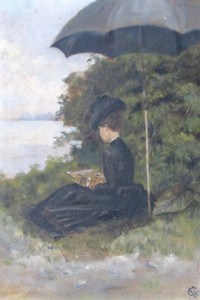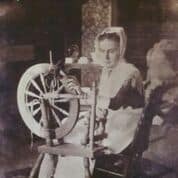Without Asking Permission: The Life of Agnes Swan Hutchins
By Alice Askin, Education Coordinator at Rose Hill Mansion
From 1850 to 1889 Robert and Margaret Johnston Swan lived at Rose Hill on Seneca Lake. The couple had three girls and three boys. Unfortunately, five of their children died young – the boys in childhood, the eldest girl, Mary, in childbirth at 33, and the middle daughter, Maggie, of heart trouble at 44. Only the youngest daughter, Agnes, lived what we would today consider a normal lifespan. Taking after her long-lived Scottish grandfather, John Johnston, she lived to be 87. Warren Hunting Smith, who knew Agnes, said in his book Gentle Enthusiasts that she did what she wanted, without asking permission.
Agnes w as born in 1864, about 5 ½ years after her next older sibling. We don’t know a lot about Agnes’s childhood. A family diary mentioned Robert taking Mary and Maggie into Geneva for school in the 1860s. Agnes probably also went to school, though we have not found her in any school records. While Agnes’s mother was raised on a farm where everybody worked, we suspect that Agnes and her sisters had a much more “genteel” upbringing. There is nothing in the family papers to suggest that the Swan girls were milking cows or preparing meals. As an adult, Agnes was a gifted artist who painted, made lace, and did needlepoint.
as born in 1864, about 5 ½ years after her next older sibling. We don’t know a lot about Agnes’s childhood. A family diary mentioned Robert taking Mary and Maggie into Geneva for school in the 1860s. Agnes probably also went to school, though we have not found her in any school records. While Agnes’s mother was raised on a farm where everybody worked, we suspect that Agnes and her sisters had a much more “genteel” upbringing. There is nothing in the family papers to suggest that the Swan girls were milking cows or preparing meals. As an adult, Agnes was a gifted artist who painted, made lace, and did needlepoint.
Agnes must have been closest to her sister Maggie, the only other sibling to outlive their parents. After their parents died, the sisters took a year to travel the world, and then rented an apartment in New York City. Maggie told a cousin that they intended to live in Geneva, but needed a good rest before settling down. Their plans, however, changed. Maggie wrote to her cousin James, from New York in February of 1894:
We had intended going South for the spring months, but an event has occurred [sic] lately that has changed everything upside down, & that is the object of my letter today, to tell you of Agnes’ engagement to Mr. Waldo Hutchins of this City – he is a lawyer – and we have known the family for some years. . . . Of course it is hard for me to give up the only one I have left of our once happy family – but of course Agnes’ joy & happiness must be the first consideration, and she certainly is very happy.
In October 1894 Agnes and Waldo were married in Geneva. They had two children – Waldo Jr (1895-1989) and Margaret (1897-1960). Waldo Jr. became a lawyer. He also bought Rose Hill and Johnston House for Historical Society, and helped enormously with the costs of restoration. Like her mother Margaret was an artist and originally owned the 1916 Model T on exhibit in our Visitor Center at Rose Hill.
During the first years of their marriage Agnes and Waldo lived in New York, and probably Maggie stayed there to be near them. Because of ill health, Waldo retired from active business in 1899. That same year Maggie died. In 1901 the Hutchinses bought a house on South Main Street in Geneva. From this time, the family appeared more often in the local papers.
In the absence of a diary or letters written by Agnes, we have to learn about her character from other sources. She seems, for example, to have had a sense of civic responsibility. In 1902, the Daily Times mentioned her work on the First Presbyterian Church committee to raise funds to furnish the new YMCA building. The next year, the Advertiser-Gazette noted that she had donated lettuce, asparagus, peas, tomatoes, beans, and 10 lemons to the City Hospital (except for the lemons, this may indicate that Agnes had a garden). She served the women’s committee to raise funds for the hospital in 1903. A year later she was on the hospital’s Board of Women Managers and in 1908 she was the head of the Supply Committee. Her interests were not strictly local. During World War I she was on a committee to collect food for Belgium, which had been invaded by Germany. In 1919 Agnes was Vice President of the local Needlework Guild, which produced clothing and household linens for charity.
The Hutchinses belonged to the local social elite. In 1903, Agnes was serving coffee at a tea that Mrs. Phillip Nicholas gave in honor of Mrs. Stewardson (the Reverend Stewardson was appointed president of Hobart College that year.) In May 1915, Agnes and Waldo’s daughter Margaret
made her debut at a charming reception given for her by her mother . . . at the Hutchins home on South Main street. Mrs. Hutchins wore a beautiful gown of white satin and black lace. Miss Hutchins, daintily dressed in white taffeta and tulle, and carrying an old fashioned bouquet of pink rosebuds and lace, received with her mother in the drawing room, which was beautifully decorated with American Beauty roses, snap dragons and pink roses. In the hall, library and dining room, masses of pink roses, white lilac and pink sweet peas were effectively used, the mantels and fireplaces being banked with them.
The Hutchinses were also travelers. They moved back and forth from New York City to Geneva with the changing seasons, and had some adventures even in New York City. The Advertiser February 25, 1902:
Another Big Fire.
This time it is the 71st Regiment Armory in New Yor[k] that is burned, and along with it the elegant Park Avenue Hotel . . . The fire occurred at about 1.30 o’clock Saturday morning, when all the guests of the hotel were asleep. The papers report from 16 to 20 dead, and a large number injured . . .
Mr. Waldo Hutchins, his wife and two children, have been guests at the Park Avenue Hotel since the middle of January . . . We are glad to learn yesterday at noon that Mr. and Mrs. Waldo Hutchins and children escaped alive and uninjured . . .
The family traveled partly because of Waldo’s ill health. At the time, people believed that travel to different climates, and exposure to sea air, were beneficial. In December1903, the Daily Times reported that the Hutchinses were sailing to Europe in the spring, for a two-year stay. In succeeding years the paper mentions the family being in New Hampshire, Vermont, California, Algiers, Paris, and Sicily. During their visit to Funchal, Madeira in 1926 an earthquake, tidal wave, and big storm hit it. The editor of the Times was worried, but again the family came through uninjured.
The Hutchinses made several visits to Egypt in 1908, 1910, and 1924. After the last trip, Agnes gave a talk to 60 women of the First Presbyterian Bible Classes, described in the Daily Times:
. . . The speaker’s very first sentence was to the effect that we should all be grateful for the privilege of living in our wonderful country. . . . in Egypt there are only rich and poor, no middle class, no schools or education . . . camels and donkeys still are about the only means of transportation. . . . Water is brought to the houses on the heads of women. . . . There are almost no changes in their mode of living since one thousand years B. C. Still, many of the people have a desire for self government. . . . Mrs. Hutchins was deeply moved by the thought that the vital difference between that land and ours is that this is a Christian nation. . . . The impressions of an eye witness made these things far more vivid than any mere reading would.
After Waldo died in 1933, Agnes and her daughter continued to live in New York City and Geneva. Eventually they sold their house on South Main and spent summers at the Chestnuts, a house on Keuka Lake. According to Warren Hunting Smith mother and daughter spent their time entertaining lavishly.
 Another interest of Agnes’ was family history, especially the story of her grandfather John Johnston. Clan Johnstone, of southwest Scotland, had a long history of raiding the borders, although they had been peaceful for quite some time before John Johnston came along. The chief of the Johnstones was also the Earl of Annandale. When Agnes was a child, her grandfather Johnston told her that his grandfather had attempted to claim the title. As Agnes understood it, her branch of the family had lost the title when they supported the wrong party in a political dispute, and her great-great-grandfather was only denied the title because he lacked the money to pursue the claim. Wikipedia, however, explains this a little differently. It says that the last Earl died without issue in 1792. Through the 19th and 20th centuries, many Johnstones tried to claim the vacant title, but no one was recognized until 1985. Agnes, though, needlepointed a seat cover for a chair that had belonged to her grandparents, with a design of the badge and motto of Clan Johnstone, and the arms of the Earl. The motto means “Never Unready.”
Another interest of Agnes’ was family history, especially the story of her grandfather John Johnston. Clan Johnstone, of southwest Scotland, had a long history of raiding the borders, although they had been peaceful for quite some time before John Johnston came along. The chief of the Johnstones was also the Earl of Annandale. When Agnes was a child, her grandfather Johnston told her that his grandfather had attempted to claim the title. As Agnes understood it, her branch of the family had lost the title when they supported the wrong party in a political dispute, and her great-great-grandfather was only denied the title because he lacked the money to pursue the claim. Wikipedia, however, explains this a little differently. It says that the last Earl died without issue in 1792. Through the 19th and 20th centuries, many Johnstones tried to claim the vacant title, but no one was recognized until 1985. Agnes, though, needlepointed a seat cover for a chair that had belonged to her grandparents, with a design of the badge and motto of Clan Johnstone, and the arms of the Earl. The motto means “Never Unready.”
Up Next: Agnes and Women’s Suffrage

Alice, which house on S. Main St. belonged to the Hutchinses?
I loved your article!
Joanne,
The Swan house was the one that stood across from the museum on South Main. It was torn down when North Cloverleaf drive was put in to connect South Main to the arterial or 5&20.
Anne
I have two rare paintings by Margaret J Hutchins of the Keuka Lake area!!
I have a little painting signed: Margaret Hutchins
Christmas 1955
I’m wondering if she was Agnes Swann’s daughter?
The painting might be of a house in Geneva. I posted it on Facebook.
Yes, Margaret was Agnes S. Hutchins’ daughter.